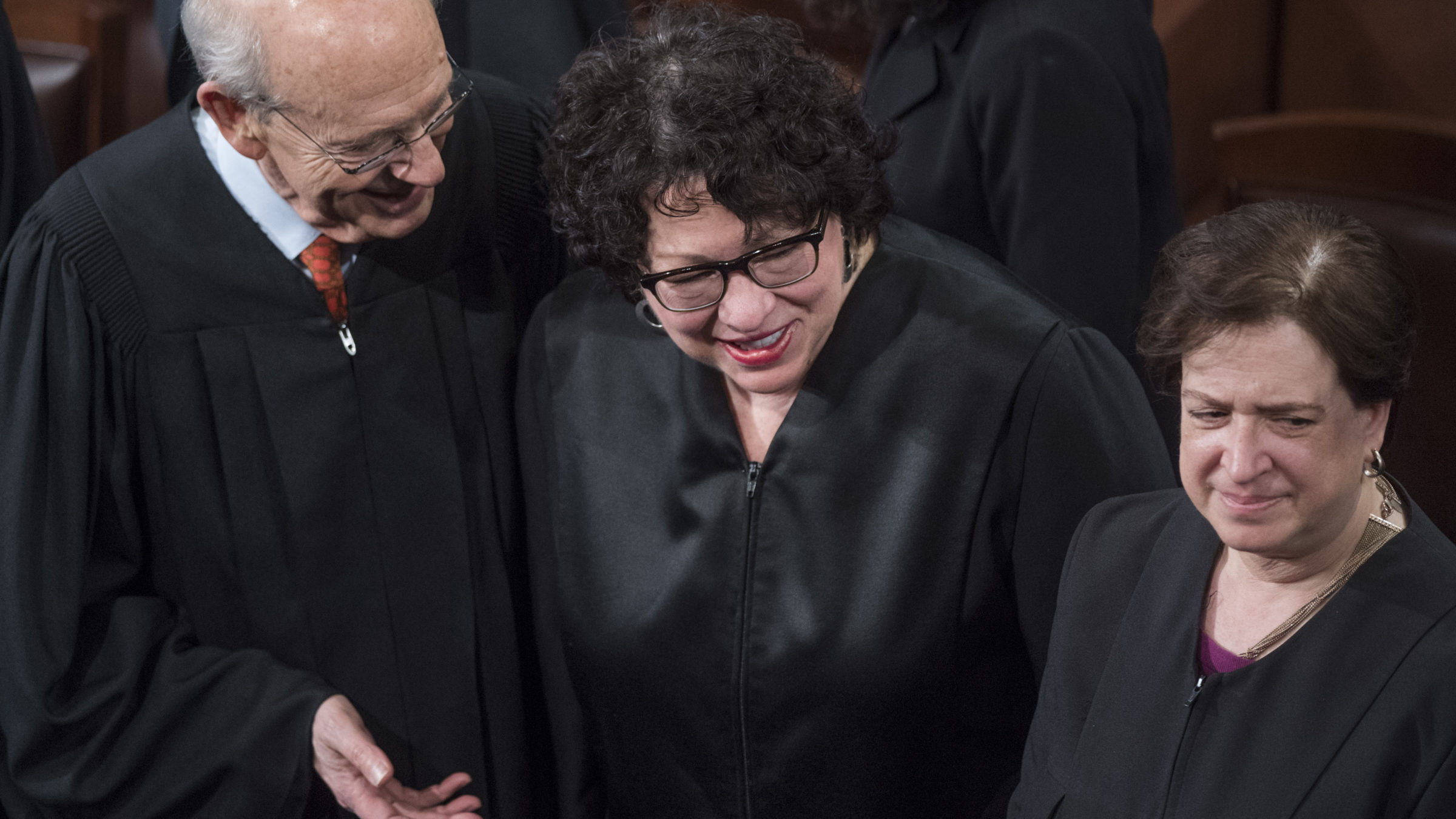In early 2022, when Justice Stephen Breyer retired from the Supreme Court, you could argue that it wasn’t entirely of his own volition. It followed a lengthy campaign of public pressure from the left, with many eager for Breyer to allow President Joe Biden the opportunity to replace him with a younger liberal justice.
The wisdom of the move was obvious: It ensured that Breyer would be replaced while Democrats controlled both the presidency and the Senate. Had he waited, he risked Republicans gaining control of the Senate and either blocking his replacement entirely or, at the least, exerting some control over who replaced him. As a result, there were widespread calls for Breyer to step aside. Despite his apparent reluctance, he did.
If Democrats are going to embrace the fact that the Supreme Court is part of the modern political battlefield, they will need to confront a simple truth: Justices Sonia Sotomayor and Elena Kagan should retire, too.
Sotomayor is a phenomenal jurist. Unlike Breyer, whose milquetoast ideals veered into outright conservative territory with some frequency, Sotomayor is the clearest liberal voice on the Court. She is a reliable liberal vote across every major issue, and a notably poignant writer on criminal justice matters, to give just one example. Kagan, though notably more moderate, is nonetheless also a consistent liberal vote, not to mention one of the most articulate defenders of voting rights in a generation. It’s the political reality, not the quality of their work, that should compel them to retire.

Greeting President Barack Obama before his State of the Union address, 2013 (Photo by Melina Mara/The Washington Post via Getty Images)
In recent decades, Supreme Court retirements have incorporated a macabre sort of realpolitik: Justices want to hang onto power for as long as possible, but they also want to ensure that their eventual replacement shares their ideological sensibilities. As a result, they are forced to triangulate between their own desire to stay on the Court, their alignment with the political party in control of the government, and an educated guess about when they might leave this earthly plane.
Although the justices themselves almost never publicly discuss this calculus, they are plainly engaging in it. It’s been over 30 years since someone left the bench while their preferred party was out of power, and that was only when Justice Thurgood Marshall’s failing health forced him to resign the position. President George H.W. Bush replaced him with Justice Clarence Thomas—about as close to Marshall’s ideological opposite as you could ever imagine.
The political maneuvering surrounding retirements has become increasingly cutthroat of late. Justice Anthony Kennedy pushed President Donald Trump to nominate Kennedy’s former clerk, Brett Kavanaugh, after announcing his retirement in 2018. Meanwhile, Republicans have thrown the full weight of their political power at every open seat: After Justice Antonin Scalia’s death, they blocked the appointment of Merrick Garland in 2016 (on the purported basis that appointments should not be made during an election year) before ramming through the confirmation of Amy Coney Barrett in 2020 (an election year).
The brazenness of the GOP’s posturing left Democrats crying foul. But behind the shamelessness of the Republican operation lies a rational calculation: The stakes at the Court are enormous, and the value of a Supreme Court seat far outweighs whatever political fallout might flow from a bit of public hypocrisy.

Trump and Kavanaugh acknowledge Kennedy at Kavanaugh’s swearing-in ceremony, October 2018 (Photo by Alex Wong/Getty Images)
Liberals have started slowly acclimating to this reality. Not only did mainstream voices call for Breyer’s resignation, but Breyer himself made his retirement contingent on the confirmation of a replacement, leaving room for him to renege if Senate Republicans were to block his successor’s appointment.
Sotomayor is 68 years old; Kagan is 62. Neither is notably old by Supreme Court justice standards, but the risk to Democrats doesn’t stem from their age alone. A very favorable electoral map will almost certainly give Republicans control of the Senate in 2024. They may well win the presidency. In either case, there’s a very real possibility that after 2024, Democrats won’t control both the Senate and the Oval Office simultaneously for over a decade. If Kagan and Sotomayor do not retire before 2024, there is a large risk that one or both of them is ultimately replaced by a Republican president. If they do retire before 2024, allowing Democrats to nominate and confirm their successors, it’s a virtual guarantee that those seats remain in liberal hands for another generation.
With the best course of action so clear, and the consequences of miscalculation so drastic, we’ve started to see calls for Sotomayor and Kagan to consider stepping down. But those calls have been few and far between, and responses from many liberals on social media have been vitriolic. Moreover, some mainstream liberal voices have openly thrown cold water on the idea. In The Nation, Elie Mystal (also a Balls & Strikes contributor) called the prospect of Sotomayor’s retirement “a tad premature,” noting that she’ll be 70 at the next presidential election. “Even if a Republican should win it,” he wrote, “absent accident or tragedy, we can expect Sotomayor to live to see the 2028 election, when she’ll be 74 (the age Thomas is now), or hang on until the 2032 election, when she’ll be 78.”
But this isn’t an argument against Sotomayor retiring now as much as it’s envisioning a world where her decision not to retire now—when Biden is already president and Democrats already control the Senate—just so happens to work out. If liberals want to take the Court seriously as a political project, they shouldn’t be merely hoping for the best case scenario to unfold. They should be preparing for the worst.

Attending remarks from President Donald Trump before a joint session of Congress, February 2017 (Photo By Tom Williams/CQ Roll Call)
When Kagan and Sotomayor leave the Court, there’s no doubt that something will be lost. Given that, it’s natural that many people are asking, “Who could possibly replace them?” It’s the wrong question. The correct question is, “Who will replace them?”
We’ve had this conversation before. In 2014, when many were calling for the retirement of the then-81-year old Justice Ruth Bader Ginsburg, Ginsburg fired back in a July interview. “Tell me who the president could have nominated this spring that you would rather see on the Court than me,” she asked the journalist Joan Biskupic. Her defenders echoed the sentiment. Professor Garrett Epps took to The Atlantic to chastise academics calling for Ginsburg to step down, and Slate’s Dahlia Lithwick authored a piece bluntly titled “Justice Ginsburg is Irreplaceable.” It was a nice compliment, but Lithwick should have thought about Ginsburg’s replaceability less figuratively, because it was Justice Amy Coney Barrett, who did, in fact, replace her.
The choice, of course, was never simply between Ginsburg and another Democratic appointee—it was between ensuring a liberal justice and risking a conservative one. Had Ginsburg been asking the right question, she may have recognized the stakes of her decision, and the situation at the Court today wouldn’t be so dire. As it stands, her mistake will resonate for generations: Had her seat been in liberal hands last year, Roe v. Wade would still be good law today.

(Photo by Melina Mara/The Washington Post via Getty Images)
Moreover, the idea that certain justices are irreplaceable has never been grounded in reality. Sotomayor and Kagan are exceptional jurists with unique perspectives. But so is Myrna Pérez, currently a federal appeals court judge and previously the director of the Brennan Center’s voting rights program. So is Holly Thomas, now a judge on the Ninth Circuit Court of Appeals, whose career has taken her from the NAACP Legal Defense Fund to California’s Department of Fair Employment and Housing. So is Rachel Bloomekatz, an accomplished public interest attorney whose nomination to the Sixth Circuit is currently pending. The proposition that no one else could do the job is institutional mythmaking, and a disservice to the array of talented lawyers who are capable of doing the work.
Even putting aside the tactical benefits, retiring from this Court should qualify as an act of self-care. One way or another, the liberal justices are likely to remain in dissent on nearly every contentious issue for the foreseeable future, under the thumb of an increasingly shameless and power-hungry conservative supermajority. Both justices have hinted at how dire they perceive the status quo to be: Kagan expressed growing concerns about the Court’s legitimacy, and Sotomayor told an audience of law professors that the Court’s recent decisions have given her a “sense of despair.” Retirement would allow both justices to speak a bit more freely, and given that no one has had clearer vision into the Court’s rightward turn, we might all benefit from hearing what they have to say.
The conservative capture of the Court has liberals scrambling to piece together a countervailing legal movement. If they want to succeed, they will need to accept that the mission involves more than bemoaning the Court’s conservative decisions. It involves strategic thinking, some gamesmanship, and, occasionally, sacrifice. And it is bigger than any one justice. Sonia Sotomayor and Elena Kagan are important. But they are important because of the values they champion. If they want to see those values protected, then they can’t risk letting their seats fall into Republican hands.




